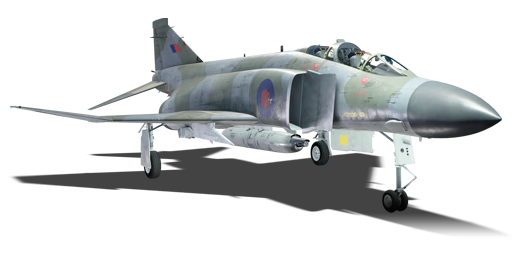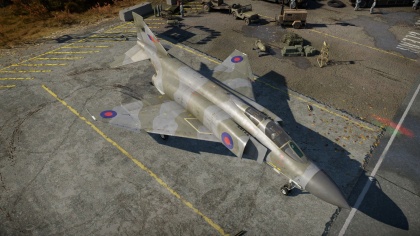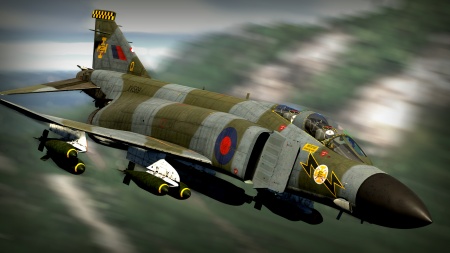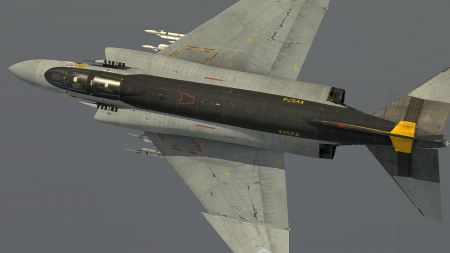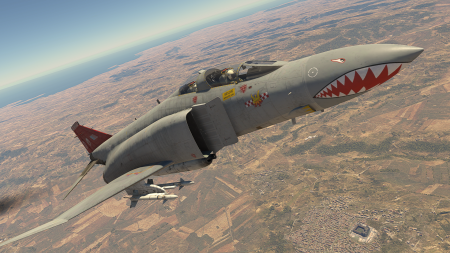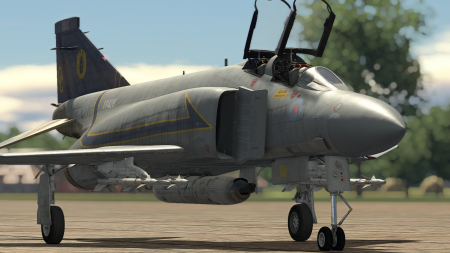Difference between revisions of "Phantom FGR.2"
(Added spaded stats) |
(Few corrections and filled in modifications advice) (Tag: Visual edit) |
||
| Line 125: | Line 125: | ||
* 4 х AIM-9D Sidewinder air-to-air missiles | * 4 х AIM-9D Sidewinder air-to-air missiles | ||
| − | Like the [[F-4C]] the Phantom FGR.2 lacks any internal guns; instead relying on a M61 Vulcan rotary cannon, mounted centrally under the fuselage. The cannon is angled downwards at about 1°, coupled with the guns position under aircraft this makes aiming slightly more difficult than on other aircraft; the gun also has a wide bullet spread. A benefit of the rotary cannon is that it can fire all 1,200 rounds of ammo before it can overheat and jam. | + | Like the [[F-4C]] the Phantom FGR.2 lacks any internal guns; instead relying on a M61 Vulcan rotary cannon, mounted centrally under the fuselage. The cannon is angled downwards at about 1°, coupled with the guns position under aircraft this makes aiming slightly more difficult than on other aircraft; the gun also has a wide bullet spread. A benefit of the rotary cannon is that it can fire all 1,200 rounds of ammo before it can overheat and jam. Unlike the F-4C the Phantom FGR.2 can only carry a single gunpod. |
In terms of other suspended weaponry the Phantom FGR.2 falls far behind the F-4C, having 6 loadout options compared to the F-4C's 21. It has a more limited choice of bombs, carries fewer rockets and cannot carry Bullpup air to ground missiles. | In terms of other suspended weaponry the Phantom FGR.2 falls far behind the F-4C, having 6 loadout options compared to the F-4C's 21. It has a more limited choice of bombs, carries fewer rockets and cannot carry Bullpup air to ground missiles. | ||
| Line 135: | Line 135: | ||
=== Modules === | === Modules === | ||
| + | The order in which you unlock modifications on the Phantom FGR.2 will depend to some extent on how you like to play the aircraft. The [[AIM-9D]] missiles are among the best available to top tier jets, and so most fans of missile combat will likely want to unlock them as soon as possible. If you do not like fighting with missiles then you may instead wish to focus on unlocking the 20 mm belts and new 20 mm cannon modification, to make the spread of the gun less extreme and more usable; and if you plan to use it as a ground attacker than the ordnance options are the obvious choice (although the FGR.2 does not excel in this role to the same extent as its american counterpart). When equipped with its 8 x 1,000 lb bombs the FGR.2 becomes highly potent bomber; using its low altitude performance to get to enemy bases incredibly quickly, you may wish to unlock the bombs and use this tactic to speed up unlocking other modifications, although FGR.2 is a capable fighter when stock so this is not a necessity. | ||
| + | |||
| + | Even when stock the Phantom FGR.2 is just about the best performing aircraft in the game at low altitude ; with this in mind flight performance upgrades are not as much of a priority as on other aircraft, so weapons upgrades can be prioritised. When unlocking flight performance upgrades you may wish to focus on engine upgrades to further improve the FGR.2's incredible acceleration and climbing performance. | ||
{| class="wikitable" | {| class="wikitable" | ||
! Tier | ! Tier | ||
| Line 173: | Line 176: | ||
* Better acceleration and climb rate than the [[F-4C]] | * Better acceleration and climb rate than the [[F-4C]] | ||
| − | * One of the fastest aircraft in the game, especially at low altitude ( | + | * One of the fastest aircraft in the game, especially at low altitude (just above sea level it can reach ~ Mach 1.17 when stock and ~ Mach 1.22 when spaded) |
* One of the fastest climbing aircraft in the game | * One of the fastest climbing aircraft in the game | ||
* Carries [[AIM-9D]] air-to-air missiles, what are mostly on par with and in some ways better than the [[AIM-9E]] found on the [[F-4C]] | * Carries [[AIM-9D]] air-to-air missiles, what are mostly on par with and in some ways better than the [[AIM-9E]] found on the [[F-4C]] | ||
* Very high rate of fire from autocannon, which does not jam | * Very high rate of fire from autocannon, which does not jam | ||
* Has tail-hook, can land on aircraft carriers | * Has tail-hook, can land on aircraft carriers | ||
| + | * Has a breaking parachute | ||
'''Cons:''' | '''Cons:''' | ||
| Line 185: | Line 189: | ||
* Missiles are tier 3 upgrade modification which needs to be researched | * Missiles are tier 3 upgrade modification which needs to be researched | ||
* Large target compared to other aircraft such as the [[MiG-21 F-13|MiG-21]] | * Large target compared to other aircraft such as the [[MiG-21 F-13|MiG-21]] | ||
| − | * Due to large weight it requires a high landing sped (~350 kph), can be tricky for players new to the fighter | + | * Due to large weight it requires a high landing sped (~350 kph), can be tricky to land for players new to the fighter (especially on aircraft carriers) |
* Not quite as good at high altitude as the [[F-4C]] | * Not quite as good at high altitude as the [[F-4C]] | ||
* Taking minimum fuel leaves you with very limited battle endurance (especially if you use the afterburner), while the 20 min fuel option noticeably impacts handling | * Taking minimum fuel leaves you with very limited battle endurance (especially if you use the afterburner), while the 20 min fuel option noticeably impacts handling | ||
Revision as of 15:33, 26 December 2019
Contents
| This page is about the British jet fighter Phantom FGR.2. For the USAF version, see F-4C Phantom II. |
Description
The Phantom FGR.2, also known as the F-4M, is a rank VII British jet fighter
with a battle rating of 11.7 (AB), 12.0 (RB), and 11.3 (SB). It was introduced in Update 1.93 "Shark Attack". It is a British version of the American F-4 Phantom II.
Although at first glance the F-4M appears very similar to its American counterpart the F-4C Phantom II, there are a number of major visual and performance differences between the two aircraft. Phantoms produced for the RAF were redesigned to use British Rolls-Royce Spey turbofan engines, instead of the General Electric J79 turbojet engines found on American Phantoms. The British engines produced more thrust than the American engines, but were larger; as a result the fuselage of British Phantoms was modified to be slightly wider than on the American models. In addition the Phantom FGR.2 has larger air intakes than the F-4C, in order to allow for the increased airflow required by the new engines. The rear of the Fuselage is also significantly different on the Phantom FGR.2; the engines are noticeably angled downwards, and due to the different afterburner arrangement on the Spey engines the exhaust ports and the surrounding area were redesigned. Most distinctively, the Phantom FGR.2 has a squared off tail, and lacks the under-nose probe of the F-4C.
In game these changes mean that the Phantom FGR.2 has much better low altitude acceleration and climb rate, compared to the F-4C, as a result of the more powerful engines. In games you will usually see the Phantom FGR.2s get off the ground and to altitude quicker than the F-4Cs; however due to the increased drag of the redesigned fuselage, and the performance characteristics of the Spey engines, it does not perform quite as well as the F-4C at high altitude, and cannot reach the same maximum speed.
General info
Flight performance
Describe how the aircraft behaves in the air. Speed, manoeuvrability, acceleration and allowable loads - these are the most important characteristics of the vehicle.
| Characteristics | |||||||
|---|---|---|---|---|---|---|---|
| Stock | |||||||
| Max Speed (km/h at 10,667 m) |
Max altitude (meters) |
Turn time (seconds) |
Rate of climb (meters/second) |
Take-off run (meters) | |||
| AB | RB | AB | RB | AB | RB | ||
| 2,195 | 2,185 | 16000 | 26.5 | 26.8 | 139.3 | 129.0 | 850 |
| Upgraded | |||||||
| Max Speed (km/h at 10,667 m) |
Max altitude (meters) |
Turn time (seconds) |
Rate of climb (meters/second) |
Take-off run (meters) | |||
| AB | RB | AB | RB | AB | RB | ||
| 2,351 | 2,268 | 16000 | 25.5 | 26.0 | 245.5 | 210.0 | 850 |
Details
| Features | ||||
|---|---|---|---|---|
| Combat flaps | Take-off flaps | Landing flaps | Air brakes | Arrestor gear |
| X | ✓ | ✓ | ✓ | ✓ |
| Limits | ||||
|---|---|---|---|---|
| Wing-break speed (km/h) |
Gear limit (km/h) |
Combat flaps (km/h) |
Max Static G | |
| + | - | |||
| 625 | ~11 | ~4 | ||
| Optimal velocities | |||
|---|---|---|---|
| Ailerons (km/h) |
Rudder (km/h) |
Elevators (km/h) |
Radiator (km/h) |
| < 810 | < 750 | < 700 | N/A |
| Compressor (RB/SB) | ||
|---|---|---|
| Setting 1 | ||
| Optimal altitude | 100% Engine power | WEP Engine power |
| 0 m | 5,120 kgf | 7,168 kgf |
Survivability and armour
Much like the older F-4C variant, the British Phantom FGR.2 is without any armour protection whatsoever - the weight savings allow the aircraft to take on more fuel or ordnance while utilising speed as its best defence. This fighter packs numerous fuel tanks, while some are located in the leading edges of the wings, the majority of the fuel tanks are located within the fuselage packed around the engines and behind the cockpit. The control lines for the Phantom FGR.2 run from the cockpit down the length of the upper fuselage to the tailplane, relatively exposed to enemy gunfire.
Fighters attempting to take down a Phantom FGR.2 should try to force it to bleed its energy in a turn with missiles - a slow Phantom is a vulnerable Phantom. Autocannons and missiles will be most effective for disabling or destroying critical components, but smaller rockets such as M/55, SNEB Type 23 or FFAR Mighty Mouse unguided rockets fired in salvos during a head-on engagement may cause enough of a scattered grouping that a Phantom FGR.2 may not be able to avoid them all and fly into at least one.
Armaments
Suspended armament
The Phantom FGR.2 can be outfitted with the following ordnance:
- 1 x 20 mm M61 Vulcan rotary cannon, gun pod mounted under fuselage (1,200 round)
- 1 x 20 mm M61 Vulcan rotary cannon + 8 х 1,000 LB G.P. Mk.I bomb
- 1 x 20 mm M61 Vulcan rotary cannon + 108 х SNEB type 23 rocket
- 1 х 20 mm M61 cannon rotary cannon + 4 х AIM-9D Sidewinder air-to-air missiles
- 1 х 20 mm M61 cannon rotary cannon + 4 х AIM-9D Sidewinder air-to-air missiles + 4 х 1000 LB G.P. Mk.I bomb
- 4 х AIM-9D Sidewinder air-to-air missiles
Like the F-4C the Phantom FGR.2 lacks any internal guns; instead relying on a M61 Vulcan rotary cannon, mounted centrally under the fuselage. The cannon is angled downwards at about 1°, coupled with the guns position under aircraft this makes aiming slightly more difficult than on other aircraft; the gun also has a wide bullet spread. A benefit of the rotary cannon is that it can fire all 1,200 rounds of ammo before it can overheat and jam. Unlike the F-4C the Phantom FGR.2 can only carry a single gunpod.
In terms of other suspended weaponry the Phantom FGR.2 falls far behind the F-4C, having 6 loadout options compared to the F-4C's 21. It has a more limited choice of bombs, carries fewer rockets and cannot carry Bullpup air to ground missiles.
In terms of air to air missiles the Phantom FGR.2 can carry four AIM-9D Sidewinder missiles; as opposed to the F-4C's choice of AIM-9B and AIM-9E Sidewinders. The AIM-9D is very similar to the AIM-9E in some ways out performs it; the AIM-9D can pull 16 G instead of 10 G and is faster, with a more powerful rocket motor. The AIM-9E however can be slaved to the Phantom's radar unlike the AIM-9D, and may track better.
Usage in battles
Describe the tactics of playing in the aircraft, the features of using aircraft in a team and advice on tactics. Refrain from creating a "guide" - do not impose a single point of view, but instead, give the reader food for thought. Examine the most dangerous enemies and give recommendations on fighting them. If necessary, note the specifics of the game in different modes (AB, RB, SB).
Modules
The order in which you unlock modifications on the Phantom FGR.2 will depend to some extent on how you like to play the aircraft. The AIM-9D missiles are among the best available to top tier jets, and so most fans of missile combat will likely want to unlock them as soon as possible. If you do not like fighting with missiles then you may instead wish to focus on unlocking the 20 mm belts and new 20 mm cannon modification, to make the spread of the gun less extreme and more usable; and if you plan to use it as a ground attacker than the ordnance options are the obvious choice (although the FGR.2 does not excel in this role to the same extent as its american counterpart). When equipped with its 8 x 1,000 lb bombs the FGR.2 becomes highly potent bomber; using its low altitude performance to get to enemy bases incredibly quickly, you may wish to unlock the bombs and use this tactic to speed up unlocking other modifications, although FGR.2 is a capable fighter when stock so this is not a necessity.
Even when stock the Phantom FGR.2 is just about the best performing aircraft in the game at low altitude ; with this in mind flight performance upgrades are not as much of a priority as on other aircraft, so weapons upgrades can be prioritised. When unlocking flight performance upgrades you may wish to focus on engine upgrades to further improve the FGR.2's incredible acceleration and climbing performance.
| Tier | Flight performance | Survivability | Weaponry | |
|---|---|---|---|---|
| I | Compressor | Fuselage Repair | 1000 LB GP | |
| II | New boosters | Airframe | Offensive 20 mm | Matra SNEB |
| III | Wings repair | G-Suit | AIM-9D | |
| IV | Engine | Cover | New 20 mm cannons | |
Pros and cons
Pros:
- Better acceleration and climb rate than the F-4C
- One of the fastest aircraft in the game, especially at low altitude (just above sea level it can reach ~ Mach 1.17 when stock and ~ Mach 1.22 when spaded)
- One of the fastest climbing aircraft in the game
- Carries AIM-9D air-to-air missiles, what are mostly on par with and in some ways better than the AIM-9E found on the F-4C
- Very high rate of fire from autocannon, which does not jam
- Has tail-hook, can land on aircraft carriers
- Has a breaking parachute
Cons:
- Gun pod is slightly angled downwards and has very wide bullet spread when stock, although this can be useful in some situations, it can make the gun hard to aim in others
- Gun pod cannot be fired while the landing gear is down
- Missiles are tier 3 upgrade modification which needs to be researched
- Large target compared to other aircraft such as the MiG-21
- Due to large weight it requires a high landing sped (~350 kph), can be tricky to land for players new to the fighter (especially on aircraft carriers)
- Not quite as good at high altitude as the F-4C
- Taking minimum fuel leaves you with very limited battle endurance (especially if you use the afterburner), while the 20 min fuel option noticeably impacts handling
- Missiles cannot be fired while you are pulling more than 4 G's, when flying at high speed even gentle manoeuvres will cause you exceed that limit
History
Describe the history of the creation and combat usage of the aircraft in more detail than in the introduction. If the historical reference turns out to be too long, take it to a separate article, taking a link to the article about the vehicle and adding a block "/History" (example: https://wiki.warthunder.com/(Vehicle-name)/History) and add a link to it here using the main template. Be sure to reference text and sources by using <ref></ref>, as well as adding them at the end of the article with <references />. This section may also include the vehicle's dev blog entry (if applicable) and the in-game encyclopedia description (under === In-game description ===, also if applicable).
Media
- Videos
See also
- Other variants in-game
- F-4C Phantom II - U.S. Air Force variant multi-role fighter-bomber which could be outfitted with various autocannons, rockets, missiles and bombs. This aircraft is an effective fighter, ground-attacker and bomber. One of the fastest fighters currently available in War Thunder.
- Aircraft of comparable role, configuration and era
External links
Paste links to sources and external resources, such as:
- topic on the official game forum;
- encyclopedia page on the aircraft;
- other literature.
| Britain jet aircraft | |
|---|---|
| Blackburn | Buccaneer S.1 · Buccaneer S.2 · Buccaneer S.2B |
| British Aerospace | Harrier GR.7 · Sea Harrier FRS.1 (e) · Sea Harrier FRS.1 · Sea Harrier FA 2 |
| British Aircraft Corporation | Strikemaster Mk.88 |
| English Electric | Canberra B Mk 2 · Canberra B (I) Mk 6 · Lightning F.6 · Lightning F.53 |
| Gloster | Meteor F Mk 3 · Sea Meteor F Mk 3 · Meteor F Mk 4 G.41F · Meteor F Mk 4 G.41G · Meteor F Mk 8 G.41K · Meteor F Mk.8 Reaper |
| Javelin F.(A.W.) Mk.9 | |
| de Havilland | Vampire F.B.5 · Venom FB.4 · Sea Venom FAW 20 · Sea Vixen F.A.W. Mk.2 |
| Hawker | Sea Hawk FGA.6 · Hunter F.1 · Hunter F.6 · Hunter FGA.9 · Harrier GR.1 · Harrier GR.3 |
| Panavia | Tornado GR.1 · Tornado GR.4 · Tornado F.3 · Tornado F.3 Late |
| SEPECAT | Jaguar GR.1 · Jaguar GR.1A · Jaguar IS |
| Supermarine | Attacker FB 1 · Attacker FB.2 · Scimitar F Mk.1 · Swift F.1 · Swift F.7 |
| Foreign | Phantom FG.1 (USA) · Phantom FGR.2 (USA) · F-4J(UK) Phantom II (USA) |
| Australia | F-111C |
| India | ▄MiG-21 Bison |
| South Africa | ▄JAS39C |


